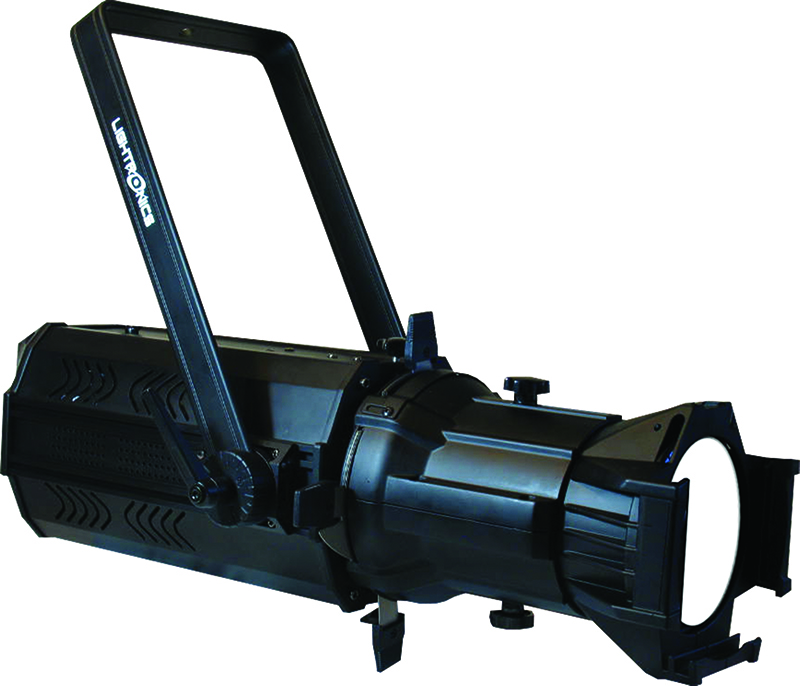
Every industry deals with shorthand, i.e., lingo, jargon, techno-babble. Often these terms become so habituated that we scarcely stop to remember their origin or consider their contemporary accuracy. It seems as though not a month goes by that I don’t think or write about some industry-specific term that has shifted in meaning over the years, and this month is no different. LED-based “ellipsoidals” are becoming ubiquitous, in certain sectors even more so than their incandescent lookalikes.
For as long as the world has had stage lighting, we’ve described fixtures vis-à-vis their optical systems, but now these terms are becoming depreciated. “ERS” doesn’t quite fit this class of fixtures, as they contain no ellipsoidal reflectors whatsoever. “Leko” is both inaccurate and terribly dated. Perhaps going forward we should stick with “profile,” as most light fixtures with a hard edge, zoom capability and framing shutters are using that label. But since Lightronics is listing their fixture as an ellipsoidal, we will stick with that.
Regardless of terminology, this month we’re discussing the FXLE3030W, the 300-watt LED ellipsoidal from Lightronics, to see how it stacks up against the competition and incandescent sources in general.

A Closer Look
Physically, the unit follows a familiar form factor, with a body housing the power supply and electronics where the lamp would be in the rear and a lens tube in a barrel at the front of the fixture. The FXLE3030W comes complete with a lens tube in your choice of common beam spreads: 19°, 26°, 36° or 50° spreads are available. The light source for the fixture is an array of warm white LEDs arranged in a circle pattern behind some optics in the body of the fixture. These have a total power draw of 300W, and in my testing produced a very flat, even field free of hotspots or other unwanted defects. The fixture has smooth, even dimming, down to the very bottom of the range.
I recorded 6,545 lux from a distance of five meters with a 26° lens tube, down from 7,200 lux at initial power-on 30 minutes earlier. This represents a thermal drop of about 10 percent. Interestingly, the dimming curve it follows is mostly linear, which most other conventional theatrical lights do not follow. It will be up to the end user to apply a dimming curve that works best for them at the console, as the curve cannot be altered within the light itself. The bumps in the top end of the range are a touch pronounced, though I suspect they are due to the fixture’s cooling making the LED array more efficacious, bumping the output up over the course of the several seconds that it took me to record the value on my light meter. In practice, I would expect normal-duration fades to be smooth.
The luminaire has a thermostatically-controlled fan to help cool the fixture. It will throttle itself up or down depending on how warm the fixture gets. Lightronics lists the color temperature of the warm white LED array at 3000K; I measured 3,160K with my light meter, which is extremely close.
The FXLE3030W has a limited number of options: my sense is that Lightronics intends this fixture to be a (nearly) drop-in replacement for 750-watt incandescent fixtures. To that end, there are only two fixture personality modes: one and two channels. The one-channel personality obviously gives you control over the dimmer, while the two-channel mode adds a strobe channel, with synchronous strobes in the first half of the channel, and short “pulses” with increasingly longer off periods in between pulses in the second half of the channel.
The lens barrel feels solidly-engineered, featuring nearly all-metal construction and high-quality glass optics. All of the expected controls are here: two knobs to loosen and tighten the lens barrel for focus, knobs to loosen the lens barrel itself for gobo alignment, and the entire body adjusts smoothly within the yoke.
This fixture has two metal handles for adjusting the tilt of the fixture within its yoke. The yoke attachment point can also be moved back and forth along the housing of the fixture for unusual rigging situations or easy balance with heavier lenses in use, a feature I appreciated. The provided lens barrels also include a standard gel frame to add color to your fixture. Shutters, as expected, are included for cutting and shaping the beam. I saw little to no chromatic aberration with the shutters, nor when I dropped a gobo in place.
The FXLE3030W has the standard slots for a standard A-size gobo/pattern holder and an iris/accessory slot. The fixture accepts power in through PowerCON-style “turn and lock” ins and pass-throughs, and its power supply auto-ranges input voltage from 100V to 230V. The fixture measures 28-by-13-by-20 inches tall (71.12 x 33 x 50 mm) and it weighs 23 pounds (10.4 kg). On the rear of the fixture, DMX in is accepted via 3-pin XLR connectors, with four buttons and a small display for accessing the personality and address functions of the lights. Lightronics offers the FXLE3030W in both black and white body versions for installations where one color might be preferred over the other. With an IP rating of 20, this is an indoor-only fixture, which shouldn’t be an issue for most users, especially those using this fixture as a replacement for 750-watt incandescent fixtures. The fixture includes a single M-size gobo holder and gel frame and power cord.
At-A-Glance:
Basic, Perhaps, but Solid
The FXLE3030W is a basic offering, but features high build quality and solid performance for houses of worship, entertainment venue installations and other applications that need a bright profile fixture with a minimum power draw.
Lightronics FXLE3030W
PROS: Good build quality, adjustable attachment point for odd hanging positions
CONS: Three-pin DMX is non-standard, older-style PowerCON-style power inputs
MSRP: $1,850
Manufacturer: Lightronics
More Info: www.lightronics.com


